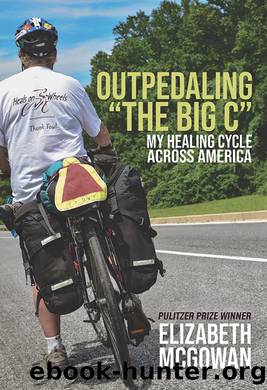Outpedaling the Big C by Elizabeth McGowan

Author:Elizabeth McGowan
Language: eng
Format: epub
Publisher: Bancroft Press
CHAPTER 22
EASTERN COLORADO: FROM THE ROCKIES TO THE GRAIN RANGE
MILES RIDDEN: 2,009
MILES TO GO: 2,241
Bicyclists eastbound on Highway 67 take a sharp left turn onto Highway 96 near Wetmore, Colorado. That intersection is where the southerly trajectory from Oregon ends and a more straightforward easterly route begins. I arrived at that juncture on the morning of September 22, pulling on my rain jacket just as looming nimbus clouds wetted Wetmore.
While waiting out the worst of the cloudburst on the porch of a closed restaurant, I tempted four feral cats living under the house next door with cheese pretzels. They seemed content to accept the human snacks as their breakfast. Temperatures tipping between the high sixties and low seventies made for comfortable riding despite intermittent showers.
Since leaving the Cañon City campground that morning, I had pedaled through rocky canyons and past an array of buttes. Cholla cactus, prickly pear cactus, and sagebrush reigned. Wetmore marked more than a distinct topographical transition from the Rocky Mountains to the plateau of the Great Plains; one day I had been staring affluence in the face near Vail, and forty-eight hours later I was shaking hands with Hardscrabble, USA. Mountain ranges formed naturally from rising rock were replaced with man-made peaks that I had christened the Grain Range. Residents must either be hard of hearing or merely immune to the steady, day-in and day-out, irritating whine of these ubiquitous grain elevators. Maybe to them, it sounded like money.
Just twenty-eight miles beyond Wetmore lay Pueblo, a city I always associated with those public service announcements broadcast on long-ago late-night television. They touted an assortment of federal government information packets free to any alert citizen who dialed a toll-free number or wrote to a post office box in that Colorado city. I had long pictured the city as a settlement flush with acre upon acre of identical Quonset huts that served as repositories for millions of those pamphlets. On my ride, however, I found no such structures. But I did note that Pueblo served as the physical halfway point of my journey. Itâs roughly where I started to tabulate miles to go before miles already pedaled. Yes, I still had more than twenty-one hundred miles ahead of me, but it was a psychological boost.
Pueblo had humble beginnings in 1842, when three fur traders built a fort at the confluence of Fountain Creek and the Arkansas River. The community was dubbed El Pueblo because buildings were made of mud and logs, mimicking the adobe dwellings of Indians of the Southwest. A village soon prospered because of its proximity to the gold and silver mines of South Park, to the north, and to coal mines to the south. Later, mineral reserves and the hydroelectric potential of the Arkansas River attracted smelting operations.
Unfortunately, the outskirts of Pueblo, now a community of almost a hundred thousand, sported strip malls and the same eyesore of urban sprawl consuming acres of this countryâs countryside and former farmland. However, unless it was just wishful
Download
This site does not store any files on its server. We only index and link to content provided by other sites. Please contact the content providers to delete copyright contents if any and email us, we'll remove relevant links or contents immediately.
Melania and Me by Stephanie Winston Wolkoff(1048)
The Class of 83 by Hussain Zaidi(991)
Orlando by Virginia Woolf; Mark Hussey(982)
Live in Love by Lauren Akins & Mark Dagostino(974)
Dancing in the Mosque by Homeira Qaderi(945)
A History of My Brief Body by Billy-Ray Belcourt(902)
Virginia Woolf by Between The Acts(763)
Just as I Am by Cicely Tyson(749)
Stranger Care by Sarah Sentilles(742)
The Schoolgirl Strangler by Katherine Kovacic(739)
Robespierre: A Revolutionary Life by Peter McPhee(736)
The Common Reader, Book 1 by Virginia Woolf(730)
1914 by Luciano Canfora(724)
Unforgetting by Roberto Lovato(723)
Ariel (english and spanish Text) by Sylvia Plath(717)
Broken Horses by Brandi Carlile(711)
Harriet Tubman: The Biography by University Press(710)
Paris Without Her: A Memoir by Gregory Curtis(706)
Berlin Diary: The Journal of a Foreign Correspondent 1934-41 by William L. Shirer & Gordon A. Craig(702)
